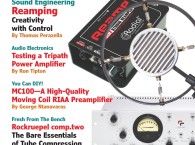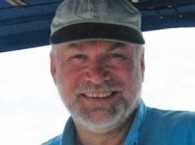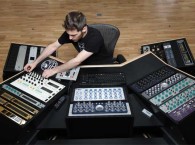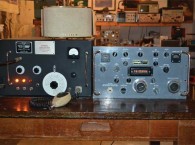Shannon Becker interviews Ken Heng Gin Loo, the founder of the diy-audio-guide.com website. Ken is of Malaysian Chinese origins, and studied in the United Kingdom, where he concluded a bachelor’s degree in Electrical and Electronics and later graduated in Electrical and Electronics Engineering (Honors) from the University of Manchester, UK. Today he lives in a beautiful tropical island named Pulau Pinang (aka Penang) in Malaysia. Ken has a passion for DIY audio, in particular tube amplifiers, Tripath amplifiers, high-efficiency loudspeakers, and high-quality audio reproduction.

Shannon Becker: Tell us about your background and where you live.
Ken Heng Gin Loo: I’m a Malaysian Chinese. I spent a wonderful childhood in a small and peaceful town called Taiping, Perak, up North in Peninsular Malaysia. I’m fortunate that my father could afford to send me overseas to the United Kingdom to pursue a bachelor’s degree after locally earning my diploma in Electrical and Electronics. Now, I’m a graduate in Electrical and Electronics Engineering (Honors) from the University of Manchester, UK.
I currently live on a beautiful tropical island named Pulau Pinang (aka Penang) in Malaysia. It is an urbanized and industrialized state that houses several the multinational corporations (e.g., Intel, Agilent, Motorola, Altera, National Instruments, etc.). Yet, it retains its historical heritage and it is one of the UNESCO World Heritage sites. Downtown is filled with historical sites, excellent local delicacies and seafood, and many beachside resorts.
I live in a terrace house with my lovely wife Brenda and 3-month-old baby girl Ember. In the past, I worked as an engineer for several multinational corporations. Now I work at Intel (for more than eight years) as an applications engineer. I focus on customer-enabling team program management, working with high-speed electronics applied in tablets, notebooks, and PCs.
Shannon Becker: How did you become interested in audio electronics?
Ken Heng Gin Loo: I was “trained” in hi-fi very early, way back in my primary school years. I’m fortunate to have a hi-fi enthusiast as a father. He plays vinyl, and previously used cassettes before moving to CDs in the 1990s. I was brought up (or spoiled?) with high-quality stereos since I was a youngster.
I started to like tube equipment when I heard the combination of a Unison Research Simply 2 and a B&W 601S2 speaker in a shop in Hsinchu, Taiwan. I seriously started to create DIY audio projects when I was working in Taiwan in early 2000. A friend, who was also a tube dealer, introduced me to his DIY 300B tube amplifier that was driving a pair of vintage Tannoy 15” dual-concentric speakers. It was the Tannoy GFR, if memory serves me right. The sound they produced was made in heaven and no setup that I’d encountered at that time was close to producing what I heard that day.
I was hooked on the glowing tubes. I started reading about vacuum tubes online, in books, and in magazines (e.g., Sound Practices, Audio Amateur, audioXpress, etc.). I wanted to learn more about vacuum tubes so that I could build a sound system of my own. I also started “wasting” money collecting NOS tubes for my future projects. Now, I have more tubes than I will ever need in my entire lifetime. Maybe if my daughter inherits my interest in audio technology, she will find a use for them. Who knows?

Shannon: Describe your first personal project. Why did you build it? Is it still in use?
Ken Heng Gin Loo: Tube amplifiers were still uncommon in those days and purchasing one was costly. It was definitely out of my budget when I was a young engineer. Back then, an ordinary tube amplifier alone was two or three times my monthly pay. Since I have knowledge in electrical engineering and electronics (well, sort of, since I studied all solid-state electronics), I thought I would attempt to build a tube amplifier. I thought making a tube amplifier from scratch certainly would not be difficult for me. So, I started building tube amplifiers because the DIY methods made them accessible to me.
A Taiwanese friend assisted me with my first build. He did most of the design work and I did all the soldering since I was still very new to DIY tube amplifier construction. It was a two-stage all triode amplifier with a 300-B direct heat triode driven by a 5842 miniature triode. The sound was sweet and warm even though it was (un?)matched with a small B&W 601S2 bookshelf speaker. (I still have this pair of speakers today!) They are definitely 10 times (exaggerated!) better than all the entry solid states I owned or bought when I was in the UK.
My true first 100% built-by-myself project was an all Russian Reflektor 6C45PI with a 6C33CB triode mono-block tube amplifier. I read an article about a 15-W SE 6C33C-B amplifier that Erno Borbely published in Glass Audio magazine. His article sparked the idea for my own project. I used his design to build my own 6C33C-B amplifier circuit. “I’m a mischievous youngster! I’m an engineer! I can do much better than him!” So I thought. Well, it didn’t go that well.
Shannon: What kinds of audio projects do you build? Can you share some of the challenges involved with the designs?
Ken Heng Gin Loo: I build speakers, pre- and power amplifiers, DACs, subwoofers, mains filters, and almost any kind of audio-related gadget. Some of the projects I have built over the years include: Class-D amplifiers with Philips and Tripath integrated circuits, Gain Clone clones (LM3886 and LM1875), Fostex FE167E bass reflex bookshelf speakers out of real wood, a Fostex FE167E in TQWT enclosure, an Altec 640D in Altec 620D cabinet, several 300B SE amplifier variations, 45 SE amplifiers, 6B4G amplifiers, an 1H4G preamplifier, a 6SN7 preamplifier, a 5687 preamplifier, a 6C45PI SPUD, a 5842 SPUD, an EL34 single-ended amplifier, a Tannoy HPD385A active crossover, and many more that I can no longer remember.
I still have some of the completed projects. I’ve also posted a few of them on my website (www.diy-audio-guide.com). DIY audio is challenging in many aspects, especially if you want your designs to sound really good and be reliable. To get something to work is easy. To master it is rather difficult.

Some of the most challenging areas for me include:
Aesthetics — I admit this is one of the challenges I always face. I do see that there are a lot of DIY designs online that look fantastic, almost as good as commercial designs. But for the projects to look good, you need to spend significant time, effort, and money from the design’s start until the end. However, my bias would lean more toward sound than looks. For my projects, I definitely spend more time on the design and the components rather than the finished look.
Test and Measurement — This is something I find really challenging on financial and knowledge terms. My daily job includes testing and measuring computer motherboards for power, signal integrity, compliance, eye diagram, and so forth. I use a lot of test and measurement equipment (e.g., multimeters, LCR meters, oscilloscopes, spectrum analyzers, and various other meters). This equipment is expensive and not something an ordinary DIY guy can afford to purchase for personal use. An oscilloscope can cost more than a house in Penang.
Measurement Methodology — This is a topic on its own. A different methodology or setup yields different results and that is sometimes misused because end users occasionally deviate from the figures/specifications that matters the most. Audio design is an art. Or perhaps it is better to say audio design is a black art? When I was a young graduate, I thought that if I got the circuit right, good sound would follow. It is not that easy! Everything matters, from component selection to the layout.
I’m often amazed that some people think tidy wiring equals good sound. This will not guarantee good sound, but it does help future troubleshooting.
Separating Truth from Fiction — One thing I personally do not like is trying to differentiate among the hype or claims with hidden/personal agendas. I was, and sometimes I still am, tricked into buying something (DIY parts/components) that does not perform as claimed. There are many out there. So, beware!
Last but not least, the biggest challenge for all DIY audio hobbyists is that DIY audio projects often involve carpentry and electrical/electronic, which can sometimes be dangerous. You must work with sharp objects, live electrical connections, and tools. Take precautions and be safe.

Shannon: What has been the most creative project you’ve received on your website?
Ken Heng Gin Loo: I received these two amazing DIY speaker and DIY tube amplifier projects from Siegfried (Sigi) Maiwald of Wuppertal, Germany. One day, I met Sigi via the website’s feedback form and we became good friends due to our DIY audio hobby.
Sigi’s approach to DIY audio, his attention to detail and workmanship, not to mention his energy (and strength to manage such a humongous speaker), and spirit are simply outstanding. In terms of creativity, he used a broom as the support/stand for a multi-cellular horn! In addition, he used the “?O186” as an inexpensive substitute for the ultra-rare and ultra-expensive RE604, which is definitely cool. I would not have known you could do that. Too bad the project suffered at the end due to a mishap.
You can check out Ken's projects (write-up and photos) at www.diy-audio-guide.com/sigi-audio-setup.html and at www.diy-audio-guide.com/RE604-tube-amplifier.html.

Shannon: With all the products that are available, why do you think audiophiles continue to experiment and build their own equipment?
Ken Heng Gin Loo: DIY audio is one of those continuing trends. Fanned by the increasing price of audio equipment, it remains popular among the DIY-audiophiles. Everyone wants a piece of high-end equipment but the disproportionate price vs. performance and the return of investment places many high-end products out of reach for the general community.
Cost aside (DIY is not inexpensive either!), I’m sure DIY audiophiles will continue to design and build because of the satisfaction and enjoyment they receive when listening to their own creations and masterpieces! I am proud to say that I made most of my home audio gear! aX
This article was originally published in audioXpress, December 2013.






